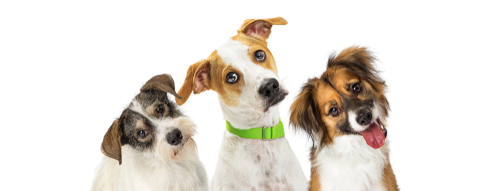By the time you have brought your new puppy home, he’s already old enough to begin basic obedience training. Commands like “sit,” “stay,” “down,” and “leave it,” are all excellent examples of commands you should teach during your first lessons. But what happens if—like most owners of new puppies—you find that your furry friend’s attention span is about three seconds long? Today, we’re going to share 5 Tips to Build Your Dog’s Attention Span.
Successfully capturing—and holding—your dog’s attention during training is the foundation of all other work the two of you will do together. Your puppy needs you to teach him how to focus his attention during training. Once he has learned to pay attention, he’ll be able to learn rapidly. Success in training will increase his self-esteem, which will further boost his motivation and focus during the next session!
Tip 1: Only Use Your Dog’s Name Positively
It’s vital not to use a dog’s name when you’re correcting him. We often see owners saying things like, “Rover, NO. Rover, bad! Stop that, Rover!” Then, when the dog’s name is used during training, or to offer praise, the dog can’t experience these situations positively because he has so many negative associations with his name. This dog will not be cooperative during training, and may even want to escape the session instead.
To create positive associations with your dog’s name, prepare a few chopped bits of something delightful he normally doesn’t get; dried liver, chicken, cheese, and smelly fish jerky are great.
With your dog leashed and seated in front of you, happily focused on the bit of treat you’ve got in your hand, say the dog’s name in a happy, upbeat tone. As with all dog training, treat timing here is essential: offer the treat immediately once he looks up at you!
Continue this positive, happy training session for a few more repetitions. It’s important that you don’t allow your dog to become bored or full. When you see that he’s bored, restless, or hungry (usually after an hour or so), you can try a few more repetitions.
Tip 2: Training and Refining “Watch Me”
After sufficient training with his name, your dog should whip around and look at you when you say his name in an upbeat tone. With this behavior in place, you’re ready to move on to one of the most important commands an owner can teach a dog.
To teach “Watch me!” you’ll hold a high-value treat next to your eyes. Say, “Rover, watch me!” and reward the dog immediately when his eyes meet yours. Soon, you’ll drop his name and instead use the command alone.
Over days and weeks, you’ll gradually ask your dog to increase the time he’s expected to keep his eyes on you; eventually, he will stay in place with his gaze locked on you even if you move about or turn your back.
Tip 3: “Watch Me!” On the Move
Once he’s solidly learned “watch me,” try working with your dog on his morning walk. As you near a spot that usually catches his attention (sign posts and tree trunks are popular), say, “Rover, watch me!” in your cheeriest voice. When he looks up at you, choosing your gaze over the exciting destination, reward with praise and a treat.
Tip 4: Overcoming Distraction
Over time, you’ll be able to expect your dog to look at you no matter what’s happening, so “watch me” will be a command that you’ll want to continue to work on in various situations.
Initially, you can have a friend or loved one toss a bouncy ball or squeaky toy past your dog. When he’s able to stay focused on you despite the enticing distraction, reward him lavishly! Remember, this is hard work for your young dog.
Increase the distractions by working in the park, near a school playground, or by active squirrels. Choose something that you are certain will make it challenging for him to keep his eyes on you, reward him with carefully-timed treats and praise, and remember to keep sessions short and upbeat.
Tip 5: Reward Positive Choices
Rather than only rewarding your dog when he obeys your commands, it’s even more powerful to reward your dog anytime you’re pleased with his choice. If he looks up at you for instructions, praise him. If he chooses his squeaky chew toy over a pair of shoes, praise him. Make it your own game to “catch” your dog doing as many positive things as you can during the day.
Rewarding the dog positively in this manner teaches him that you’re always watching, you have opinions about his behavior, and you notice his good choices even more than his mistakes. A dog who is convinced that this is true will likely work hard for your time and attention by behaving as well as possible.
He is also more likely to keep checking in with you generally, which will translate to you having his attention almost by default. When you’re here at All Dogs Unleashed training with other dogs, or recalling your dog at the community dog park, you may decide that “watch me” and having your dog’s undivided attention is the most valuable command your dog has ever learned!



